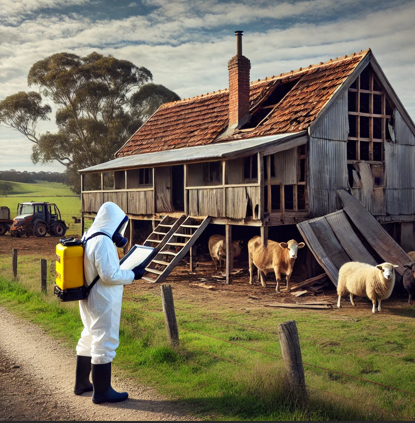When planning a strip out, it’s vital to understand the health risks posed by asbestos. Asbestos-containing materials (ACMs) were widely used in Australian buildings before the 1990s. If your project involves stripping out an older property, the risk of asbestos exposure is high. Disturbing asbestos during a strip out can release dangerous fibres into the air, which can have severe health consequences.
This article explains the health risks associated with asbestos exposure during strip outs and how to manage asbestos safely.
What Is Asbestos?
Asbestos is a naturally occurring mineral made up of tiny fibres. These fibres are strong, heat-resistant, and durable, which is why asbestos was used in a wide range of building materials. However, once disturbed, asbestos fibres become airborne and can be easily inhaled or ingested. This is where the danger lies.
Health Risks of Asbestos Exposure
Inhaling asbestos fibres can lead to serious health problems. These diseases develop over time and may not show symptoms for decades. Here are the main health risks linked to asbestos exposure:
1. Mesothelioma
Mesothelioma is a rare but aggressive cancer. It affects the lining of the lungs, chest, or abdomen. Asbestos exposure is the only known cause of mesothelioma. Once diagnosed, mesothelioma is often fatal, with limited treatment options.
2. Asbestosis
Asbestosis is a chronic lung disease caused by inhaling asbestos fibres. It leads to lung scarring, which makes it difficult to breathe. The scarring worsens over time, causing more severe respiratory issues. There is no cure for asbestosis, and it can lead to other serious conditions, including heart failure.
3. Lung Cancer
Long-term exposure to asbestos increases the risk of lung cancer. The risk is much higher for smokers. Lung cancer caused by asbestos exposure has similar symptoms to other forms of lung cancer, such as a persistent cough, chest pain, and shortness of breath.
4. Pleural Plaques and Thickening
Prolonged exposure to asbestos can also cause pleural plaques and thickening. These are non-cancerous conditions affecting the lung lining. Although not life-threatening, pleural thickening can reduce lung function and may signal a higher risk of more serious diseases like mesothelioma or asbestosis.
Why Strip Outs Increase Asbestos Exposure Risks
During a strip out, many materials are removed or demolished, such as walls, ceilings, and flooring. If these materials contain asbestos, fibres are easily disturbed and released into the air. Asbestos fibres are microscopic and can stay suspended in the air for long periods, making them easy to inhale without realising the danger.
When inhaled, these fibres embed themselves in the lungs and other organs. Over time, this can lead to the development of the serious health conditions described above. This makes strip outs particularly dangerous if asbestos is not handled correctly.
Common Areas Where Asbestos Is Found During Strip Outs
Asbestos was commonly used in many building materials that may be removed or disturbed during a strip out. These include:
- Ceilings and Wall Sheeting: Asbestos cement sheets were widely used in ceiling and wall linings.
- Roofing: Asbestos cement was also used in roof sheeting and external cladding.
- Flooring: Vinyl tiles, linoleum, and their adhesives often contain asbestos.
- Insulation and Pipes: Asbestos was frequently used in pipe insulation and ductwork.
How to Minimise Health Risks During a Strip Out
Managing asbestos during a strip out is critical to preventing exposure. Here’s how to protect your health and the health of others during the process:
1. Get an Asbestos Inspection Before Starting
Before any strip out begins, it’s essential to have an asbestos inspection. A licensed professional will inspect the property to identify asbestos-containing materials. This step ensures that asbestos is properly managed before the strip out disturbs dangerous fibres.
At Phase One Asbestos, we provide thorough asbestos inspections for strip outs. Our team identifies all ACMs in your building, ensuring your project proceeds safely.
2. Hire Licensed Asbestos Removalists
Once asbestos has been identified, it must be removed by licensed asbestos removalists. DIY removal is illegal and extremely dangerous. Only licensed professionals have the expertise and equipment to remove asbestos safely. At Phase One Asbestos, we are fully licensed to remove both friable and non-friable asbestos in compliance with all safety regulations.
3. Use Proper Containment and Disposal Methods
During the strip out, the asbestos removal area must be sealed off to prevent fibres from spreading. Personal protective equipment (PPE), such as respirators, should be worn by all workers. Once asbestos is removed, it must be disposed of at a licensed facility.
Phase One Asbestos ensures all work areas are properly contained, and asbestos waste is handled and disposed of according to Victorian regulations.
4. Ensure Air Monitoring and Clearance Certification
After asbestos removal, air monitoring is conducted to ensure that no asbestos fibres remain in the environment. A clearance certificate is issued once the area is confirmed to be safe. Without this certificate, further work cannot legally continue.
At Phase One Asbestos, we provide air monitoring and clearance certificates after asbestos removal, guaranteeing your strip out is safe and compliant.
Why DIY Asbestos Removal Is Dangerous
Attempting to remove asbestos yourself is illegal and highly dangerous. DIY removal increases the risk of asbestos fibre release, contaminating the worksite and endangering everyone nearby. Even minimal exposure to asbestos can have life-threatening consequences later in life.
Licensed professionals, like Phase One Asbestos, follow strict safety protocols, using advanced techniques and equipment to ensure safe asbestos removal. This includes setting up containment areas, using air filtration, and wearing protective gear to keep everyone safe.
Trust Phase One Asbestos for Safe Strip Outs
If you’re planning a strip out in Frankston or surrounding areas, Phase One Asbestos can help. We specialise in asbestos management for strip outs, ensuring that asbestos is safely handled and removed before your project begins.
Our Services Include:
- Asbestos Inspections: Identifying ACMs before the strip out starts.
- Licensed Asbestos Removal: Safe removal of asbestos from your site.
- Air Monitoring and Clearance Certificates: Ensuring your project is asbestos-free and compliant.
Protect Your Health During Strip Outs
Asbestos exposure during a strip out can have serious long-term health effects. By understanding the risks and following the correct safety procedures, you can protect yourself and others. Contact Phase One Asbestos today to schedule an asbestos inspection and ensure your strip out is asbestos-free and safe.
See our article on testing methods for asbestos and The Importance of Asbestos Clearance Certificates After Strip Outs





